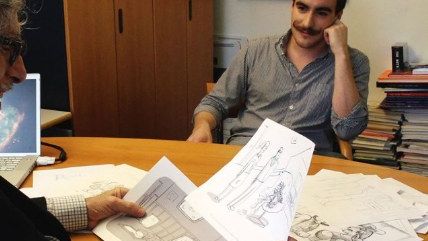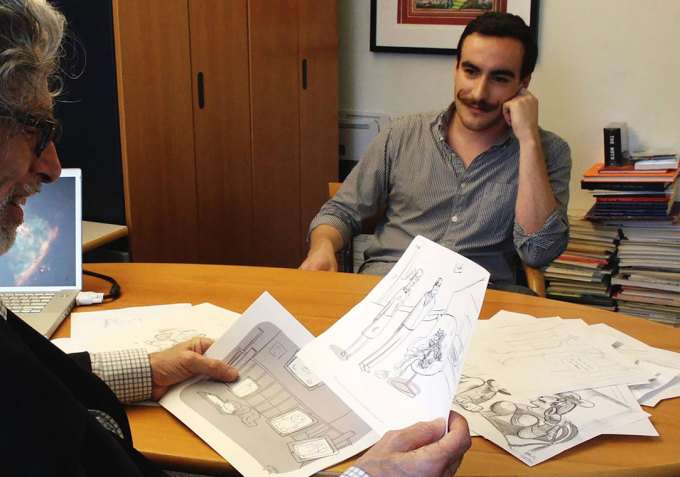The Semi-Crazy Life of New Yorker Cartoonists
HBO documentary explores what it takes to get the weirdness published.


Very Semi-Serious: a Partially Thorough Portrait of New Yorker Cartoonists. HBO. Monday, December 14, 9 p.m.
For years, legend had it that The New Yorker tracked the sketchy mental health of its mordant cartoonist Charles Addams by his submissions. Whenever he resubmitted an oft-rejected drawing of a ghoul telling a maternity-ward nurse he didn't need a blanket for his new-born baby—"Don't bother to wrap it, I'll eat it here"—it was time to swear out a new set of commitment papers.
Like so many priceless anecdotes, that one eventually fell victim to some reporter churlishly checking facts. (Though Addams had, once, turned in a sketch with a woman chatting in a maternity ward. "I'm worried about Albert," she tells her friend. "He eats his young." It wasn't published, but Addams wasn't carted away in a straitjacket, either.) But judging from the wry new HBO documentary Semi-Serious: A Partially Thorough Portrait of New Yorker Cartoonists, the tale of the ghoul cartoon may been spiritually if not literally accurate: These people are a twisted if probably not dangerous bunch.
Consider Roz Chast, who has sold more than 1,200 cartoons to The New Yorker, including a memorable selection of get-well cards for bad moods. (Angst: Under a rat's nest of black scribbles, the advice, "Run yourself a nice hot bath, and stay away from Sylvia Plath".) She confesses timidly that she rarely goes outside: "The temperature's never right….There's branches, there's ticks…"
Or Emily Flake, who despite publishing a hundred times or so in the magazine, detests its readers ("organic good-buying, private-school, artisanal-trend kind of—basically stupid cracker shit") and chafes at its prim standards on sexual humor. Her recent motherhood has neither mellowed her nor stopped her from banging her head on the wall of the submission rules. "I still submit dick jokes," she says defiantly. "But now they're baby dick jokes."
And then there's Liana Fincke, a young graphic novelist (or, as we used to say, comic-book artist) just trying to break into The New Yorker. As she stumbles awkwardly through her first meeting with the cartoon editor, he notes, not unkindly, that neither her work nor her personality is exactly mainstream. "It might be Asperger's," she volunteers earnestly.
Like the off-kilter characters who populate it, Semi-Serious meanders in stream-of-consciousness style through the quirky world of The New Yorker's cartoon department, a landscape of crushed egos, burbling neuroses, and general weirdness that is scarcely comprehended even by the rest of the magazine. In one understated but hilarious scene, The New Yorker's buttoned-down editor David Remnick is gamely but uncomprehendingly paging through the department's weekly candidates for publication. He brightens as he gets one of the jokes. "He's holding an already-inflated condom!" What the cartoon actually shows isn't visible to the viewer, but judging from the horrified expressions of the cartoon editors, the punchline did not include condoms.
One of those editors is Bob Mankoff, the crusty, socially impaired boss of the cartoon department and the central presence of Semi-Serious. A talented cartoonist himself (he drew the iconic panel of a harried Wall Street executive barking into the phone, "No, Thursday's out—how about never? Is never good for you?), Mankoff is widely credited for making The New Yorker a less clubby venue for artists, even holding open court once a week for anyone who wants to drop by with some roughs, as preliminary sketches are called.
Nonetheless, it often seems like Mankoff's principal role at the magazine is extirpating the hopes and dreams of young cartoonists. One regular attendee refers to the open auditions, where Mankoff will look at about a thousand cartoons and buy maybe 15, as "going into the magazine for weekly humiliation." Mankoff's dismissals are quick, brutal and often cryptic: "Vampires are over. … This is just a wordplay joke. And we've been doing clones. … I like the idea. But not this idea particularly."
The marathon public sessions are hardly the place for long disquisitions on the nature of visual humor, of course, but Mankoff seems scarcely more analytical in his private moments with the camera. His appraisals of the work of The New Yorker's hall-of-fame cartoonists range from meaninglessly broad ("what Addams did was, he made gothic horror funny") to incomprehensible clumps of buzzwords. On Saul Steinberg, who drew the classic New Yorker cover "View of the World from 9th Avenue" lampooning Manhattan's self-importance: "He saw not only humor but philosophy. … It could be an art and it could be an aspirational enterprise." Contrast that with Mankoff's idea of a New Yorker cartoon he'd like to see: "I think it would be fairly funny if a robot could fall on its ass slipping on a banana peel."
Semi-Serious is no more acute in explaining why cartoons work, or don't. And to be fair, a lot of cartoon humor simply defies analysis. In one scene, Saturday Night Live writer Zach Kanin gives the camera a glimpse of a cartoon he's about to submit. It shows two people about to meet as they come around a city corner. One is a man, walking a bowling ball on a leash; the other a woman with a leash of her own, attached to a set of 10-pins. The Semi-Serious camera crew breaks into laughter at the sight of the cartoon, as I did watching in my living room. But what, exactly, makes it so funny? Anthropomorphism? Jungian archetypes? A profound national longing for the return of Chris Schenkel? Who the hell knows?
That's why the most insightful moment in Semi-Serious may be a peek inside the little notebook of ideas carried by one prospective cartoonist as he awaits a no-doubt painful interview with Mankoff. It's filled with prospective captions for cartoons as yet undrawn and likely to stay that way. The girl with the regrettable tattoo. The wolf who cried boy. The boy who cried squirrel. The boy who cried sloth. And then there's a crude sketch of a lumpy snake titled Still Life With My Anaconda, Two Rabbits And My Niece Rachel. Quick, write that man a check.


Show Comments (1)